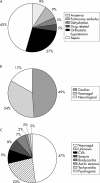Does the use of a syncope diagnostic protocol improve the investigation and management of syncope?
- PMID: 14676242
- PMCID: PMC1768011
- DOI: 10.1136/heart.90.1.52
Does the use of a syncope diagnostic protocol improve the investigation and management of syncope?
Abstract
Objectives: To assess the efficacy of a protocol designed to improve the diagnosis and management of syncope.
Design: Prospective outcome analysis of all patients presenting with syncope for the 12 month period from 1 November 2000 to 31 October 2001, compared with a retrospective study of all patients presenting with syncope during the calendar year 1998. Use of the protocol commenced in September 2000.
Setting: Eastbourne District General Hospital, serving a population of approximately 250 000; 25% are older than 65 years.
Subjects: 421 consecutive patients presenting with syncope, investigated prospectively in January 2000 and compared with 660 patients retrospectively analysed for the calendar year 1998.
Results: In 1998, 71% of patients with syncope received a diagnostic classification. In January 2000 there was an appropriate diagnostic hypothesis for every patient. Ultimately a diagnosis was made for 78% of patients according to accepted criteria (p = 0.003). Use of tests with the highest diagnostic effectiveness, such as tilt tests, increased in 2001 and many tests were used more appropriately (such as echocardiography). However, non-diagnostic tests were still frequently used (such as chest radiography, electroencephalography, and carotid Doppler studies). Costs of investigation and hospital stay rose from pound 611 to pound 1384 (euro;874 to euro;1980) per patient (p < 0.001), with cost per diagnosis increasing from pound 870 (euro;1245) in 1998 to pound 1949 (euro;2790) (p < 0.001).
Conclusion: The syncope protocol improved diagnosis and the use of appropriate investigations. However, significant inappropriate investigation and hospital admission still occurred. The protocol allowed reliable triage of syncopal patients into high and low risk groups.
Figures



References
-
- Savage DD, Corwin L, McGee DL, et al. Epidemiologic features of isolated syncope: the Framingham Study. Stroke 1985;16:626–9. - PubMed
-
- Chen L, Chen MH, Larson MG, et al. Risk factors for syncope in a community-based sample (the Framingham Heart Study). Am J Cardiol 2000;85:1189–93. - PubMed
-
- Murdoch BD. Loss of consciousness in healthy South African men: incidence, causes and relationship to EEG abnormality. S Afr Med J 1980;57:771–4. - PubMed
-
- Williams RL, Allen PD. Loss of consciousness. Aerosp Med 1962;33:545–51. - PubMed
-
- Gendelman HE, Linzer M, Gabelman M, et al. Syncope in a general hospital patient population: usefulness of the radionuclide brain scan, electroencephalogram, and 24-hour Holter monitor. N Y State J Med 1983;83:1161–5. - PubMed
Publication types
MeSH terms
LinkOut - more resources
Full Text Sources
Medical
